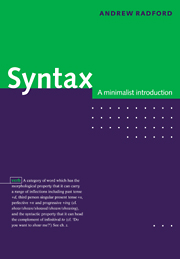2 - Categories
Published online by Cambridge University Press: 05 June 2012
Summary
In the previous chapter, we concluded that the structure dependence principle determines that all grammatical operations in natural language are category-based (i.e. apply to whole categories of words or phrases rather than to individual expressions). In this chapter, we provide further evidence in support of this conclusion, and argue that a principled description of the grammar of any language (the language chosen for illustrative purposes being Standard English) requires us to recognize that all words in the language belong to a restricted set of grammatical categories.
A natural question to ask at this point is: ‘What does it mean to say that words belong to grammatical categories?’ We can define a grammatical category in the following way:
(1) A grammatical category is a class of expressions which share a common set of grammatical properties.
For example, by saying that words like boy, cow, hand, idea, place, team, etc. belong to the grammatical category noun, what we are saying is that they all share certain grammatical properties in common: e.g. the morphological property of having a plural form (ending in the suffix +s), and the syntactic property of being able to be premodified by the. As is implicit here, the bulk of the evidence in support of postulating that words belong to categories is morphosyntactic (i.e. morphological and/or syntactic) in nature.
- Type
- Chapter
- Information
- SyntaxA Minimalist Introduction, pp. 29 - 60Publisher: Cambridge University PressPrint publication year: 1997



